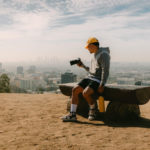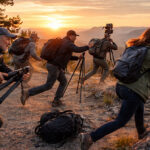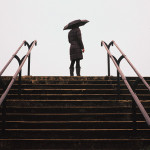Tip 1: Miss the eyes and you’ve missed the shot. Getting the eyes in focus is key to capturing a photo of an animal. It’s human nature to look at the eyes. It’s how we determine emotion and how we connect. When I was in Homer, Alaska, I came across a moose on the move. Given it was early morning and the light was low I knew getting a fast shutter speed to freeze his movement would be tough, so I quickly adjusted my camera to lock the focus on his eyes, and took the shot. The majority of the picture was a bit blurry, but because the eyes are in focus, the shot was saved.

Tip 3: Use a wide aperture. Learning the effects of adjusting your camera’s aperture will go a long way toward improving your photographs, especially in portrait style shooting. In a photo of a grazing elk I shot in Yellowstone, I chose a very wide aperture to blur out a potentially busy background and bring attention to the subject instead. As you learn to control your camera you’ll also find that adjusting your aperture will have a direct effect on your shutter speed. This will prove especially helpful when shooting in the early mornings and late evenings, when animals are typically most active and the light is warm and muted.

Tip 5: Use a flash to fill in shadows. It may sound odd, but using a flash outside on a bright sunny day actually makes a lot of sense. In this situation, you’re not using the flash to illuminate the subject, as you would in a dark setting, but rather to fill in the shadows and provide detail where harsh shadows would otherwise be heavy and dark. It’s important to use flash wisely and here are a couple of other suggestions:
Be conscious of the animal and whether flash will scare them and,
There are times where your only shoot is through glass — using a flash behind glass will ruin your shot. The glass will reflect the light back at the camera and you shouldn’t be surprised if all you get is a big white picture!
Tip 6: Plan for the best light. There’s nothing like a cloudy day to provide soft, even light for wildlife photography. Clouds act like a giant diffuser to the sun, spreading the light out evenly and taking away harsh shadows that are created by a bright, sunny day. Of course, a cloudy day has its challenges as well, such as lower light, which will force you to adjust ISO and shutter speed settings for stopping action and getting sharp, in focus images.

Tip 8: Shoot with two eyes. This is a tip I’m sharing here, but often have a hard time remembering myself. I can’t tell you how many shots I’ve missed because I didn’t see the action coming. By keeping both eyes open you’ll see the subject in the viewfinder and you’ll also see what’s going to happen next.
Tip 9: Anticipate behavior. This tip goes well with Tip 8, shoot with both eyes, because anticipating behavior is often key to capturing a rare moment, action and unique situations. Panning the camera to follow an animal can be a tiring process, so often I’ll study the animal’s behaviors watching for a pattern and then use some anticipatory shooting, and a little luck, to hopefully capture that perfect moment.
Tip 10: Use a tripod. Using a tripod is one of the best things you can do to improve your photography, and wildlife is no different. By mounting your camera to a tripod you reduce camera shake, which is usually the cause of blurry photos. To take this a step further, I use a shutter release cable, which eliminates the need to touch the camera while snapping shots and thus removes almost all potential for camera shake.

About the Author
Stephen Oachs spends every chance he gets looking through the viewfinder of his cameras. He is an accomplished nature photographer with an impressive gallery of stunning wildlife shots. Visit his photo journal at www.stephenoachs.com. Read more about him at his blog, stephenoachsphotography.blogspot.com. When not taking photographs, Stephen’s day job is spent as technical director of VisiStat.com, a leading next generation Web Analytics service that specializes in real-time Website Performance Management.
Like This Article?
Don't Miss The Next One!
Join over 100,000 photographers of all experience levels who receive our free photography tips and articles to stay current:






Leave a Reply